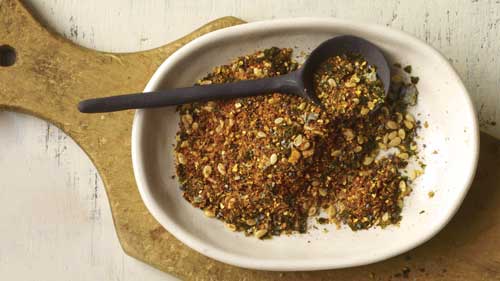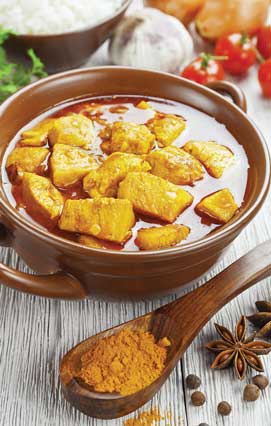Spicing Up Food Formulating
INGREDIENTS
 No plane ticket? No problem. For a trip around the world, look no further than your spice rack. There you will find cinnamon from Sri Lanka, Aleppo pepper from Syria, saffron from Spain, and so much more. Not only have spices brought people from diverse cultures together, under both positive and negative circumstances (explorers navigated the world in search of these “exotic” ingredients, forming beneficial trade partnerships, but also giving rise to colonialism), they have also changed people’s eating and cooking habits. For centuries, people have used spices and herbs to flavor and color foods and beverages and to help keep spoilage microbes at bay. Today, chefs, product developers, and home cooks continue to use spices and herbs for these purposes, but they also incorporate these ingredients in formulations and recipes to differentiate products, add global or regional cuisine characteristics to foods, and add layers of flavor to meat, vegetables, and more. Be inspired by the myriad of spices, herbs, and seasoning blends offered by ingredient manufacturers and well-stocked spice purveyors to create foods and beverages that appeal to a wide range of consumers, including those who enjoy experiencing new food flavors from around the world.
No plane ticket? No problem. For a trip around the world, look no further than your spice rack. There you will find cinnamon from Sri Lanka, Aleppo pepper from Syria, saffron from Spain, and so much more. Not only have spices brought people from diverse cultures together, under both positive and negative circumstances (explorers navigated the world in search of these “exotic” ingredients, forming beneficial trade partnerships, but also giving rise to colonialism), they have also changed people’s eating and cooking habits. For centuries, people have used spices and herbs to flavor and color foods and beverages and to help keep spoilage microbes at bay. Today, chefs, product developers, and home cooks continue to use spices and herbs for these purposes, but they also incorporate these ingredients in formulations and recipes to differentiate products, add global or regional cuisine characteristics to foods, and add layers of flavor to meat, vegetables, and more. Be inspired by the myriad of spices, herbs, and seasoning blends offered by ingredient manufacturers and well-stocked spice purveyors to create foods and beverages that appeal to a wide range of consumers, including those who enjoy experiencing new food flavors from around the world.
Spices Add Flavor Impact
Global and regional American cuisines continue to have a big impact on culinary applications and consumer packaged food and beverage products. Using authentic ingredients and drawing inspiration from regional cuisines within larger geographical regions is reflected in menu options and consumer product goods. In addition to global cuisine influencing consumers’ preferences and product development, bold, unusual, or unexpected flavors and ingredients have an effect as well. Many consumers want something different from their food, and ingredients like spices and herbs can give these consumers the taste sensations like heat, sweet, umami, herbaceous, warm, smoke, and more, and allow them to experience the foods and flavors of cuisines from around the world right in their own dining rooms or at local restaurants. “Eating is always an experience for people,” says AnnMarie Kraszewski, food scientist at Wixon Inc., St. Francis, Wis. (www.wixon.com), who explains that the more complex the flavor profiles are in a food product, the more the consumer will enjoy the product. Product developers and chefs know this and that is why they continually look for new ways to add global cuisine flair to food products, explains Barbara Zatto, director of cuisine and sales manager west for Mizkan Americas Inc., Mount Prospect, Ill. (www.mizkan.com).
Ingredient manufacturers, especially those that offer spices, herbs, seasoning blends, and flavorings, oftentimes employ marketers or scientists who keep track of the latest culinary and consumer trends affecting the food industry, and their teams of food technologists develop ingredients and routinely create innovative product concepts with them to illustrate some of the latest trends. Kim Holman, director of marketing at Wixon, explains that the cuisines of Asia, the Middle East, South America, and even regions around the United States are more familiar to consumers than ever before, thanks in part to increased travel and the popularity of cooking and food-related television shows. Wixon specializes in customizing spice and seasoning blends, drawing on inspiration from global cuisine, consumer trends, and customers’ requests, she adds, and it has developed blends such as Indian Bazaar Cardamom Rub, Bananas Foster Dip Seasoning, and Korean BBQ Wing Seasoning.
Trend information from flavorings manufacturers Sensient Flavors LLC, Hoffman Estates, Ill. (www.sensientflavors.com), and FONA International, Geneva, Ill. (www.fona.com), points out several spices and herbs—some familiar, some not so much—that either have the potential to affect product development or that have widespread appeal. Take African blue basil, for example. In the Sensient 2015 Trends to Taste list, Sensient’s trend forecasters say that this sterile hybrid of two kinds of basil with anise undertones is an up-and-coming regionally inspired ingredient that may appeal to consumers who are curious about global cuisines and regionally inspired flavors. Previous Trends to Taste lists point out other herbs and spices finding new uses in applications. Juniper berry, known best as an ingredient in gin, has been used in a range of recipes, from sweet pies to savory pot roasts, according to information in the 2014 Trends to Taste list. The Sensient analysts even learned that the chain Chipotle has used juniper berry to season carnitas. They also discovered the growing popularity of the spice blend ras el hanout—a combination of up to 20 different spices used in some Middle Eastern cuisines—at restaurants and by spice purveyors.
The jump in popularity of spice blends from Middle Eastern cuisine is due in part to the growing interest in the region’s cuisine as well as the increasing number of recently published Middle Eastern cookbooks like those written by London-based chef and restaurateur Yotam Ottolenghi, remarks Kara Nielsen, culinary director at Sterling-Rice Group, Boulder, Colo. (www.srg.com). From her research of menu offerings, she notes that sumac and spice blends za’atar and dukkah are having their moment, especially as more Mediterranean chain restaurants open.
 The trend analysts at FONA organized ingredients listed in the 2015 Flavor Radar ® report into four categories: novel, up and coming, mainstream, and everyday. A few spices appear in the first three categories. Like the experts at Sensient, the analysts at FONA highlighted juniper berry as a novel ingredient used to flavor meats, sauces, stuffing, and beverages, and used in beverage products sold in Russia, the United Kingdom, and Mexico. Black garlic is another novel ingredient noted by FONA analysts that is finding favor with American chefs at fine dining establishments but is mainly seen in packaged goods sold across Asia. Cardamom, an aromatic spice used in Indian cuisine, is an up and coming spice still used in traditional stews and curries but also in packaged goods like bars, tea, and ice cream. The FONA analysts consider curry and ginger mainstream ingredients because of their use in restaurant chains like Au Bon Pain (Thai Coconut Shrimp Soup with Curry Broth), P.F. Chang’s China Bistro (Ginger Panna Cotta), and California Pizza Kitchen (Sesame Ginger Chicken Dumplings). Product developers are using curry to season snack foods and dips and ginger to add a pungent bite to quinoa, beer, and ice cream bars. FONA also produces a monthly 10 Things You Should Know list that highlights trends and products of note. FONA called out the Egyptian spice blend dukkah, a combination of sesame seeds, coriander, cumin, nuts, and salt that can be used as a salad topping, a meat rub, or a seasoning for sautéed vegetables, in the December 2014 edition of the list and galangal, a root that is often used as a spice in soup, curries, and tea, in the October 2014 edition.
The trend analysts at FONA organized ingredients listed in the 2015 Flavor Radar ® report into four categories: novel, up and coming, mainstream, and everyday. A few spices appear in the first three categories. Like the experts at Sensient, the analysts at FONA highlighted juniper berry as a novel ingredient used to flavor meats, sauces, stuffing, and beverages, and used in beverage products sold in Russia, the United Kingdom, and Mexico. Black garlic is another novel ingredient noted by FONA analysts that is finding favor with American chefs at fine dining establishments but is mainly seen in packaged goods sold across Asia. Cardamom, an aromatic spice used in Indian cuisine, is an up and coming spice still used in traditional stews and curries but also in packaged goods like bars, tea, and ice cream. The FONA analysts consider curry and ginger mainstream ingredients because of their use in restaurant chains like Au Bon Pain (Thai Coconut Shrimp Soup with Curry Broth), P.F. Chang’s China Bistro (Ginger Panna Cotta), and California Pizza Kitchen (Sesame Ginger Chicken Dumplings). Product developers are using curry to season snack foods and dips and ginger to add a pungent bite to quinoa, beer, and ice cream bars. FONA also produces a monthly 10 Things You Should Know list that highlights trends and products of note. FONA called out the Egyptian spice blend dukkah, a combination of sesame seeds, coriander, cumin, nuts, and salt that can be used as a salad topping, a meat rub, or a seasoning for sautéed vegetables, in the December 2014 edition of the list and galangal, a root that is often used as a spice in soup, curries, and tea, in the October 2014 edition.
Keep an eye out for more smoked ingredients like chili peppers, salt, and ground pepper in seasoning blends. Zatto says that the different types of woods like hickory, alderwood, and applewood each produce a unique smoke flavor that manufacturers can call out on the package. Holman and Kraszewski note how tea is increasingly used as an ingredient, including as a seasoning in foods. Several examples of these types of seasoning blends and other products are presented throughout this article.
--- PAGE BREAK ---
 Flavor Forecast Offers Trend Insight
Flavor Forecast Offers Trend Insight
Global food trends like those mentioned in this article and the utilization of spices in different cooking and preparation methods play a big role in the McCormick Flavor Forecast ® 2015: The Future of Global Flavor report, an annual list of the trends and ingredients driving the future of flavor from McCormick & Co. Inc., Sparks, Md. (www.mccormick.com). The eight trends noted by the McCormick experts illustrate creative ways that spices add distinction to various applications (McCormick, 2014). For example, smoking spices and herbs deepens their flavor and aroma, bringing a new depth of flavor to foods and beverages, while combining coarse salt, spices, herbs, and sour-tasting ingredients like pickled ginger, sour cherry, dried mango, and lemon zest gives foods an acidic brightness, a salty taste, and subtle flavors of the spices and herbs. Try these techniques in product concepts like Peachy Bourbon with Smoked Cinnamon Bitters, Sour Cherry, Bacon, and Thyme Salt, and Pickled Ginger, Green Tea, and Chile Salt.
The McCormick experts point the compass to two locations—Japan and the Middle East—as places where spices are adding distinctive appeal to foods. One of the trends that they noted regards the globetrotting of seasoning blends from Japanese and Middle Eastern cuisine. Japanese 7 spice blend, also called shichimi togarashi, includes orange peel, black and white sesame seeds, cayenne chili pepper, ginger, Szechuan peppercorn, and nori and is traditionally used to season soba noodles, udon, beef tataki, and rice. In addition to adding flavor and heat to soups, noodles, and rice, the seasoning blend gives grilled meats and seafood a kick of heat with flavors of Japanese cooking. Shawarma spice blend captures the flavors of the shawarma sandwich, a Middle Eastern street food favorite that consists of sliced seasoned lamb or chicken and tahini sauce wrapped in a pita. McCormick’s recipe combines ground coriander seed, allspice, cinnamon, cumin, ginger, turmeric, and black pepper to be used on different types of grilled or roasted meats and in sweet applications like cakes and cookies.
 Middle Eastern cuisine also serves as a basis for another trend, the popularity of mezze. These dips and spreads such as McCormick concepts like Garlic Pepper Labneh, Roasted Beet & White Bean Dip, and Tomato & Roasted Red Pepper Spread are made with herbs, spices, and other seasoning ingredients. Dips and spreads are familiar applications to most consumers, and they offer product developers the opportunity to go beyond a traditional sour cream and onion dip in order to make their products stand out from competitors’ products.
Middle Eastern cuisine also serves as a basis for another trend, the popularity of mezze. These dips and spreads such as McCormick concepts like Garlic Pepper Labneh, Roasted Beet & White Bean Dip, and Tomato & Roasted Red Pepper Spread are made with herbs, spices, and other seasoning ingredients. Dips and spreads are familiar applications to most consumers, and they offer product developers the opportunity to go beyond a traditional sour cream and onion dip in order to make their products stand out from competitors’ products.
The report points out that certain spices and herbs pair well with foods like mushrooms, tomatoes, sweet potatoes, and nori that are high in compounds that give an umami taste. Layer the flavors of umami-rich vegetables with herbaceous notes in a sautéed vegetable side dish or salsa. Another trend involves pureeing or juicing fruits and vegetable with spices and herbs to create a base for sweet or savory sauces, dressings, and beverages. Using spices with bold flavors, and even a little heat or pungency, can add flavor complexity to pasta sauces or grilled meat, for example. Cooking methods like braising and stewing are perfect ways to allow aromatic spices to release their flavors and aromas, and for this trend, the McCormick report notes recipe ideas like Spiced Chicken Tagine, Osso Buco, and Slow Cooker Asian-style Sour Beef Short Ribs. Finally, spicy cookies like gingersnaps and snickerdoodles and the spices that give them their characteristic flavors are the basis for reimagined desserts like Gingersnap Crème Brulée and Peanut Butter Snickerdoodle Tart with Cinnamon Peanut Crust.
Seasoning Blends Reflect Interest in Global Cuisines
To help product developers infuse authentic flavors and seasonings typical of cuisines around America and throughout the world, ingredient manufacturers feature a varied assortment of spices, herbs, seasoning blends, marinades, and flavor bases. “Our access to spices continues to improve, and spice manufacturers have done a great job of bringing global spice blends into the marketplace,” says Nielsen. Notice, too, how companies emphasize a particular region in the names of the seasoning blends, indicative of how the consumers who enjoy food products that have a general global spin to them are now going one step further by seeking out regional cuisines. Both Holman and Nielsen point out the growing interest in cuisines from specific Asian countries like Vietnam, Malaysia, and India. These regions as well as others in Latin America and the United States are illustrated in many of the seasoning blend offerings from spice suppliers. One spice purveyor in Chicago, Ill., The Spice House, takes the idea of regional cuisine to another level; it offers seasoning blends that celebrate the historic and current ethnic diversity of Chicago’s neighborhoods and the traditional cuisines from these areas.
Fuchs North America, Baltimore, Md. (www.fuchsnorthamerica.com), in 2014 released three distinct seasoning collections inspired by food and culinary traditions from around the world. The Tastes of America collection includes 11 seasoning blends, nine for meat and seafood applications (All-American Meatloaf Seasoning, Cajun Country Barbecue Seasoning, Fuchs Chop House Seasoning, Hatch Chili Seasoning, Monterey Bay Fish Seasoning, Ponca City Pork Rub, Salsa en Polvo Seasoning, Savory Roast Chicken Brine, and World’s Best Burger Seasoning) and two for ice cream (Strawbañero Seasoning and Sweet Lemon Seasoning). Because of the growing interest in global cuisines, Fuchs developed two Ethnic Inspirations seasonings collections that draw upon influences of cuisines from specific regions within Latin America, Africa, the Middle East, and Asia, including Laos, Brazil, and several regions in India. Some of the offerings in the collections include Cambodian Spice Blend, Panaji Pork Rub, Yucatán Peninsula BBQ Seasoning, Laotian Larb Seasoning, Vietnamese Dressing Base, Bahia-Brazilian Churrascaria Rub, Kashmiri Lamb Seasoning, and Moroccan Harissa Rub. Other seasoning blends in the collections call out specific ingredients and foods (Piri-Piri Chicken Rub, Gochujang Seasoning, Pho Base, Nuoc Cham Seasoning, Ramen Soup Base, Babi Panggang Seasoning, and Korma Spice Blend). The company promotes the Ethnic Inspirations lines as ingredients that help product developers create “signature product offerings” for retail and foodservice.
There are particular foods that are synonymous with a certain cuisine: Pad Thai with Thai cuisine and coq au vin with French cuisine, for example. Foran Spice Co., Oak Creek, Wis. (www.foranspice.com), developed seasoning blend concepts that capture the flavors of Brazilian feijoada, Middle Eastern falafel, and Cajun boudin. Dried spices and herbs give snack foods the flavors of feijoada, a seasoned stew of black beans, beef, and vegetables. For meat and poultry applications, Foran Spice offers a falafel-style seasoning mix that includes some of the earthy and aromatic spices and herbs like cumin and parsley found in traditional falafel recipes. Boudin has a rich history in the Cajun area of Louisiana. While the recipe for this sausage can differ from neighborhood to neighborhood, it typically is made from pork, rice, bell pepper, onions, and spices like cayenne pepper and black pepper. Foran Spice’s boudin seasoning blend contains dried green bell pepper, onion, red chili pepper, and other spices typical in Cajun cuisine, and it can be used to season any number of meat and poultry applications.
Mexican and Korean cuisines and Asian curries are emphasized in seasoning blends and marinades made with different spices and herbs from Griffith Laboratories U.S.A. Inc., Alsip, Ill. (www.griffithlaboratories.com). The company’s line of regional Mexican ingredients consists of an extensive array of seasoning blends that highlight the flavors and ingredients from the Mexican regions of Jalisco (Jalisco Cook-in-Bag Seasoning with cinnamon, cloves, onion, garlic, bay leaf, and allspice), Oaxaca (Oaxacan Vegetable and Salad Dressing with brown spices, chilies, pineapple, and garlic), Chihuahua (Chihuahua Meat Rub with charred chilies, garlic, cumin, onion, and oregano), and Puebla (Puebla Mole Sauce and Snack Seasoning with ancho, guajillo, and pasilla chilies, toasted sesame, garlic, onion, and cocoa).
--- PAGE BREAK ---
Other blends in the line add a burst of flavor and aroma to grilled and slow cooked meats, seafood, snack foods, marinades, and sauces. Korean cuisine continues to capture the attention of consumers who enjoy the combination of ginger, garlic, soy sauce, and chili peppers, the latter of which play an important role in Korean cuisine. Product developers and foodservice operators can use Buldak Chicken Glaze and Buldak Chicken Marinade, Soy Scallion Marinade, Bulgogi Marinade, and Spicy Miso Glaze to season meat and poultry for frozen entrees or for foodservice applications. Kimchi Snack Seasoning and Korean Red Pepper Mix create flavorful snack foods and side dishes.
 Curries are eaten throughout Asia and are as varied as the countries from which they originate. Griffith Laboratories’ line includes Thai Green Curry Mix, Yellow Curry Mix, and Red Curry Mix seasoned with ginger, onion, lemongrass, and garlic as well as different chili peppers to give each mix a different level of heat intensity from mild (green) to hot (red). Other curry mixes in the line are Malaysian Curry Mix, a blend of ginger, fennel, cinnamon, garlic, coconut and tomato used in Singapore noodles, Rendang Curry Mix, an Indonesian dry curry seasoning blend that is mixed with a small amount of oil and used as a rub for beef or lamb, and Golden Curry Seasoning, a Japanese variation of an interpretation of Chinese curry, which itself was an interpretation of an Indian curry. Massaman Curry Paste Mix combines ginger, garlic, onion, coriander, clove, cinnamon, cumin, and cardamom to create a curry that is typical of those served throughout Southern Thailand and Cambodia, while the Sambar Podi Cook-In-Bag Mix is a South Indian pungent and aromatic spice powder of mustard seed, cumin, turmeric, fenugreek, chili peppers, coriander, and black pepper for vegetables and legumes.
Curries are eaten throughout Asia and are as varied as the countries from which they originate. Griffith Laboratories’ line includes Thai Green Curry Mix, Yellow Curry Mix, and Red Curry Mix seasoned with ginger, onion, lemongrass, and garlic as well as different chili peppers to give each mix a different level of heat intensity from mild (green) to hot (red). Other curry mixes in the line are Malaysian Curry Mix, a blend of ginger, fennel, cinnamon, garlic, coconut and tomato used in Singapore noodles, Rendang Curry Mix, an Indonesian dry curry seasoning blend that is mixed with a small amount of oil and used as a rub for beef or lamb, and Golden Curry Seasoning, a Japanese variation of an interpretation of Chinese curry, which itself was an interpretation of an Indian curry. Massaman Curry Paste Mix combines ginger, garlic, onion, coriander, clove, cinnamon, cumin, and cardamom to create a curry that is typical of those served throughout Southern Thailand and Cambodia, while the Sambar Podi Cook-In-Bag Mix is a South Indian pungent and aromatic spice powder of mustard seed, cumin, turmeric, fenugreek, chili peppers, coriander, and black pepper for vegetables and legumes.
Heat Is Hot
One topic brought up by the experts interviewed for this article and company trend information referred to throughout the article is the taste sensation of heat. “Research points out that consumers’ palettes are significantly more mature than they have been in the past, and they’re really looking for that spicy flavor profile,” states Holman. “We’re seeing this specifically in snack foods, but we’re also seeing it across all categories from center of the plate to side dishes.”
Chili peppers come to mind first when talking about hot and spicy food, but other foods like ginger, cinnamon, mustard seed, peppercorns, and Szechuan peppercorn contribute heat, pungency, or warmth. Nielsen points out how chefs are trying to incorporate different types of chili peppers like ghost pepper and piri piri in meals and cites the limited-time offering Ghost Pepper Wings from Popeyes Louisiana Kitchen as an example. Increasingly, ground and crushed chili peppers like guajillo, pasilla negro, and ancho are available on their own or in seasoning blends. Some (brave) spice purveyors like Savory Spice House, Denver, Colo., even carry ground ghost pepper, the hottest chili pepper in the world.
There is more to chili peppers and other pungent ingredients than heat, though. Each chili pepper variety has its own characteristic flavors, the types of cinnamon differ in flavor and spicy nuances, and Szechuan peppercorn produces a tingling sensation in the mouth. “People are trying to refine what they are doing with heat levels and types of heat,” says Zatto, whose company, Mizkan, sells a range of different chili peppers in a variety of sizes and forms. “It used to be about how hot something was and how hot you could make it. Now, it’s about finessing the outcome of the complete dish.” Layering the heat-inducing ingredients with the flavors of other ingredients creates seasoning blends that can give sweet heat, bitter heat, grassy heat, or fruity heat, she adds.
Combining chili peppers with onions, garlic, naturally derived flavorings, and spices, Sensient Natural Ingredients, Turlock, Calif. (www.sensientnaturalingredients.com), developed a line of Chili Blends dry seasonings that illustrates the concept of layering flavors. Inspired by the cuisines of India, Thailand, Morocco, Latin America, and the United States, the seasoning blends are formulated for topical use or as a base for chips and other snack foods, dips, dry mixes, condiments like sauces and spreads, side dishes like rice or noodles, and prepared foods. Product developers can choose from Red Sriracha, All- American Hot Sauce, Indian Curry, Thai Arbol Chile, Moroccan Harissa, Spicy Buffalo, and Pickled Jalapeño, each with varying levels of heat and distinct tastes like sweet, umami, salty, buttery, citrus, or vinegar.
Next month’s Ingredients section will examine the power of protein ingredients.
--- PAGE BREAK ---
 Ingredient Roundup
Ingredient Roundup
Looking for more ingredient solutions to season your latest food product development? Consider the following options for improvements and enhancements.
• Seasoning sheets and roasting bags from Flavorseal, Avon, Ohio (www.flavorseal.com), are coated with a liquid sugar adhesive and spice blends of various formulations. The spices are transferred when coming in contact with the moisture in the meat. This means a more consistent coating and less waste, according to the company.
• Scientists at Kalsec, Kalamazoo, Mich. (www.kalsec.com), have developed techniques to isolate specific components from a variety of herbs, spices, alliums, and chili peppers that can add pungency and heat or contribute to the flavor and aroma profile of food products like seasoning blends.
• Soy sauce is used to add savory and umami tastes, but there are some applications like dry seasoning blends where liquid soy sauce is not appropriate. Kikkoman Sales USA, San Francisco, Calif. (www.kikkomanusa.com), produces dehydrated soy sauces and granulated soy sauces made from its naturally brewed Kikkoman Soy Sauce for use in powdered mixes and concentrated bases for soup, bouillon, sauces, dips, seasoning rubs, condiments, snack coatings, and cured meat products.
• EZ-Caps™ essential oils and oleoresins are said to provide a consistent flavor and aroma from batch to batch because they are encapsulated and then spray dried into a powder. Naturex, Avignon, France (www.naturex.com), produces these from spices, herbs, and chili peppers like allspice, cumin, cinnamon, pink pepper, chives, tarragon, cilantro, cayenne, pasilla, and ancho.
• As a leading supplier of spices to the food industry, Newly Weds Foods, Chicago, Ill. (www.newlywedsfoods.com), uses its Kitchencounters™ global culinary multimedia program to keep up to date on the global food industry and trends affecting product development. To that end, the company’s food technologists and culinary professionals work with customers to develop seasoning blends that focus on the leading trends, helping product developers formulate foods and beverages that appeal to consumers who demand bolder flavors and unexpected ingredients.
• Sriracha chili sauce is one of the more popular chili sauces in stores today. PowderPure, The Dalles, Ore. (www.powderpure.com), has captured the sweet, garlic-y flavor of sriracha chili sauce in a powder form made from sriracha sauce for use in seasoning blends, breading/coating systems, Asian cuisine–style entrees, snacks, and pizza.
• Spicetec Flavors & Seasonings, Carol Stream, Ill. (www.spicetec.com), can help snack food product developers create seasoning blends that focus on trendy flavors to garner consumer interest. The company produces ground and soluble spices, essential oils, herbs, oleoresins, and seeds to season salty snacks of all kinds.
--- PAGE BREAK ---
 Pass the Salt
Pass the Salt
Salt is neither a spice nor herb, but it does serve important functions in seasoning foods by improving flavor, intensifying flavor, reducing bitterness, and enhancing sweetness. In many seasoning blends, it is one of the top ingredients. Morton Salt Inc., Chicago, Ill. (www.mortonsalt.com), offers its Morton® Table Salt and Morton Sea Salt products as well as options that are lower in sodium for retail and foodservice customers.
Consumers can also find a comprehensive range of other salt varieties from salt supplier SaltWorks Inc., Woodinville, Wash. (www.saltworks.us). The sea salt ingredients offered by the company are sourced from such places as Hawaii, El Salvador, Bolivia, France, Brazil, and Peru. Each sea salt has distinctive flavors, colors, and texture. For additional flavor and aroma, the company manufactures smoked sea salt versions and a range of naturally flavored sea salt that features sea salt combined with black truffle, green chili pepper, chipotle, espresso, ghost pepper, habanero, jalapeño, lemon, lime, matcha, roasted garlic, or smoked serrano. All of the sea salt varieties can be used in seasoning blends, desserts, confections, and sauces or to season vegetables, pastas, and other side dishes.
www.ift.org
Members Only: Read more about spices, herbs, and seasonings online at www.ift.org. Type the keywords into the search box at the upper right side of the home page.
 Karen Nachay,
Karen Nachay,
Senior Associate Editor
[email protected]
